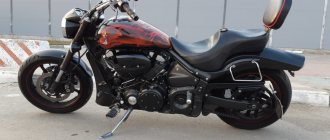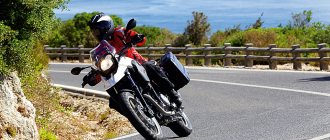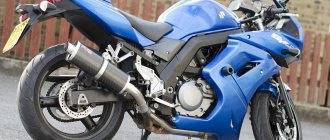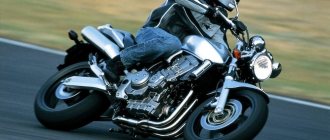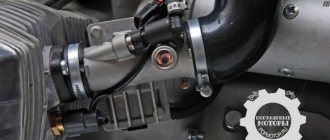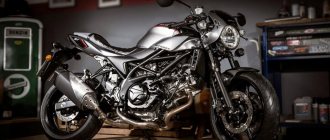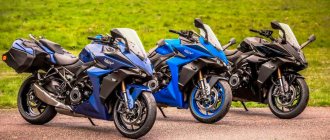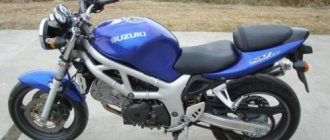Who would have thought that the Suzuki SV650 city motorcycle would attract so many loyal fans when it appeared in 1999. Today, almost 20 years later, the model can be said to have cult status. A favorite among club racers, the Suzuki SV650, powered by a V-twin engine, has proven its worth on many tracks. In addition, it is friendly to beginners, but at the same time aggressive enough to bring a smile to the face of seasoned pilots.
2017 SUZUKI SV650
Description
The Suzuki SV650 series of road motorcycles appeared on the market in 1999 and was aimed at export to Europe, North America and Australia. For the domestic Japanese market, a 400 cc modification was proposed - Suzuki SV400.
The introduction of the SV series was driven by Suzuki's desire to gain export market share by offering a cheaper competitor to Ducati motorcycles. Past experience of the TL1000 has shown that there is quite a high demand for such motorcycles and a certain “army” of fans. Thus, 2 modifications of the SV650 series were offered: naked and sport. Towards the end of production, a full-fledged sports modification appeared, distinguished by a full plastic body kit.
Suzuki SV650 is a regular naked version. Existed from 1999 to 2009. Suzuki SV650S is a sports modification. Existed from 1999 to 2012. Was in higher demand. It was distinguished by a plastic fairing, lower handlebars and high footpegs. Suzuki SV650SF (Sport) is a full-fledged sports modification. Existed from 2008 to 2009. inclusive in the US and UK markets. It is distinguished by the presence of a full plastic body kit. The Suzuki SV650 series was based on a 2-cylinder V-shaped (90°) liquid-cooled engine with a volume of 645 cm³, producing from 65 hp. (until 2003) up to 72 hp (since 2003). Due to the characteristic forward lean of the engine, it is visually reminiscent of Ducati engines, often referred to as L-shaped. Since 2003, the engine received an injection power system, and since 2007 - 2 spark plugs per cylinder.
Among the key features of the SV650, in addition to the engine, we can highlight an aluminum frame, a simple suspension in the form of a conventional telescopic fork at the front and a monoshock absorber at the rear, simple 2-piston front brakes (versions with ABS available since 2007), an injection power system (since 2003) with dual SDTV throttle valves, 17 liter fuel tank (since 2003), 6-speed gearbox and from 165 kg dry weight.
In 2003, the model underwent a major restyling, receiving a new frame, injector, dashboard, larger fuel tank and other suspension settings (+ the front fork received preload adjustment).
In 2007, the model receives 2 spark plugs per cylinder and modifications with ABS. In 2008, Suzuki offers a new version of the Suzuki SV650SF, which is sold in the UK market under the name Suzuki SV650 Sport.
In 2009, the regular version of the Suzuki SV650 is no longer offered, replaced by a new model - the Suzuki SFV650 Gladius. The SV650S version continues to exist on the market in parallel, up to 2012 inclusive, after which it finally leaves the assembly line.
In 2016, Suzuki decides to resurrect the SV650 model, launching the classic-style model of the same name - Suzuki SV650 (2016+).
Review of the Suzuki SV 650 motorcycle
I bought a Suzuki SV650. The engine runs flawlessly, quite cleanly, there are no interruptions throughout the entire speed range, and spins up instantly without any problems. The Suzuki SV650 has normal traction from minimum revs, revs up to ten thousand, and a uniform and stable pickup was felt all the time. Vibrations in the engine are felt from seven thousand revolutions, and after ten thousand they begin to get on your nerves. The gearbox didn’t leave a very good impression, maybe I just don’t have the proper experience, but it’s difficult to catch neutral, and when shifting at medium and higher speeds it slows down.
The handling is good, so far it has not caused any complaints, on a straight stretch of road, at a speed of one hundred and twenty kilometers it holds confidently, and it takes turns at sixty to eighty quite well. He doesn’t feel very confident on broken asphalt; fear comes over such areas. The brakes are simply excellent.
We didn’t really like it - the gearbox, small glove compartment, long clutch travel, poor wind protection, after one hundred and twenty it starts to blow off the motorcycle. I liked it - the lack of plastic, the comfortable fit, the engine, the dynamics of the motorcycle, good handling on city streets, low gas mileage.
In general, we can draw the following conclusions: at first glance, a very good and reliable motorcycle for beginners, good in traffic jams. It’s not entirely suitable for long distances, but it’s still more urban.
The motorcycle is super. Traveled for 2 seasons, mileage 6000, changed oil, spark plugs, air filter. The only downside is that the spare parts are expensive.
I drove the SV650S for 5 years, then sold it. I thought a lot and chose what to buy, but I couldn’t find a replacement and bought a new SV650S. As a result, after 7 years of operation, I can draw conclusions: the gearbox works excellently, this also applies to the engine, the chassis of the updated model is slightly better. Overall, I am very, very pleased with the device, and if the desire to change the motorcycle comes, then I think it will be the SV1000S.
The V-twin is quite an interesting engine, its thrust at the bottom and at mid-speed of the tachometer simply cannot but please, and the roar if you give the exhaust a direct-flow can just caresses the sound, it’s not the sound of a chopper, it’s the sound of something like a V6 V8 in cars, reminiscent of the sound of Gelika (Mercedes G55 AMG)
The engine itself is quite reliable if it is operated under normal conditions, but what it does not like and is afraid of is goats, stoppies and low oil levels in the engine. As soon as the oil is gone, and you don’t keep track of it, giving it a dry load, there is a high probability that the liners will turn!!! But the engine itself hardly eats oil during normal operation (if it is alive, I mean the engine). I drove in modes from 4 thousand revolutions to 6, maximum to 7, but basically you can move dynamically from 4 to 6 and an adequate consumption of 5 liters per 100 km. A full tank before reserve is enough for 250-255 km with spirited driving (this is before reserve), the manual says 260 km before reserve. Full tank 16 liters, reserve 3.5 (first reserve).
Regarding the oil consumption, I drove 3.5 thousand km on it, filled it with 5100 10w40 Motul, filled it with oil, didn’t add any more, and by 3.5 thousand oil consumption was not noticed, maybe it was eaten, but it was not visually noticeable (measured oil was not always made in one place)
When I sold the motor, a mechanic inspected it, examined everything and everyone, and I’ll tell you that SVeha, with a mileage of 23,500 thousand km on the engine, or rather on compression, showed almost what the manual writes. We checked the oil, the tendencies towards love spells of the liners and there was no smell. We listened, with mileage, valve noise appeared in the rear cylinder, but this is to the mechanic’s “musical” ear (in general, according to the manual, valve adjustment is done at 24 thousand km)
Regarding the characteristics of the suspension, I will say that the rear shock absorber is quite adequate, I initially had it at 4, but it seemed a little soft to me, I adjusted it to the 5th position. After these manipulations, the rear of the motorcycle became more rigid, especially when turning at a good angle, it somehow became more stable, and small irregularities began to be felt more, but at speed it goes through them well.
It’s hard to say much positive about the fork, initially it was very soft, it often broke in deep holes, but it swallowed other irregularities with a bang... And another unpleasant property that is typical for a soft fork is swaying...
But all this can be solved by placing a spring or bushing under the fork, or ideally a piece of another spring, in order not only to preload, but also to improve its progressive characteristics. Simply replacing the oil with a thicker oil will not solve the problem, because the problem is the softness of the springs.
Regarding gas tanks, Suzuki sometimes has a problem, gas tanks rust, before buying, inspect the gas tank (rub the inside with your finger or something else), lift it, look at the bottom of the gas tank!!!
In terms of comfortable fit, I compare it with the Kawasaki ZZ-R 400 and Honda CB400 SF, the SVaha has a very comfortable fit, the clip-ons, although low and quite wide, have never had a backache or tired arms during the entire time!!! And on the same ZZ-R, everything hurt me. The seat itself is quite hard, but over time the butt gets used to it and becomes comfortable. The material on the seats is quite good; in the back seat there is a cushion that you rest your butt against while lying on the tank. By the way, in this position, even with my height, it was quite comfortable and I didn’t rest my helmet anywhere.
Regarding the brakes, they are, in principle, adequate, but the front brake, as for me, is rather weak for such a dynamic motorcycle, although if you release the brakes correctly + lower the gears, it will become rooted to the spot. The twin engine brakes very well.
I was pleased with the light of the main headlight, both low and high. Let me remind you that the optics are separate, in European versions there is a lens installed in the low beam headlight, in US versions there is simply a reflector. I had a lens + a stock lamp, there was enough light, although I could have installed an Osram night braker. With such optics you can do without collective farm xenon. The high beam is quite well made, immediately illuminating everything ahead and the right side of the road.
I would say the wind protection is excellent, for a small face + stock glass, it was comfortable to drive up to 150-160 km per hour. Then I had to bend down, and at speeds above 180 I simply lay down on the tank.
Regarding revolutions, 4700 according to the tachometer is equal to 100 km per hour, 7 thousand is approximately 160.
Mirrors... how could I forget about them, visibility in them is very satisfactory, although no, I give it excellent! And they are adjustable in different positions, on the whole I am satisfied with them, Suzuki did a great job here.
There is a compartment under the rear seat that contains a manual, a stand for the tank and a set of tools. What else you can stuff in there are a few more keys and a rag to keep the bike clean.
Crashpeds, ahem) I advise everyone to install crashpeds here since the places for their installation are very reliable, what’s especially pleasing is that they are attached through an axle, or on one stud through the frame and the engine!!! The quality of the frame is excellent, good rigidity and a beautiful frame!
In general, a good motorcycle, but not for annealing in the red zone, but for dynamic riding at low and medium engine speeds, believe me, in these modes it rides as it should! Will it speed up? yes, please, even without downshifting it pulls like a locomotive! Reliable? Reliable. It's a great value for the money, but you have to love the V-twin before it's going to be an enjoyable ride.
Brief history of the model
1999 - start of production and sales of Suzuki SV650 and Suzuki SV650S. First generation. Model: Suzuki SV650; Suzuki SV650S (Europe, North America, Australia). Factory designation: SV650X, SV650US; SV650SX, SV650SUX.
2000 - no significant changes. Model: Suzuki SV650; Suzuki SV650S (Europe, North America, Australia). Factory designation: SV650Y, SV650UY; SV650SY, SV650SUY.
2001 - no significant changes. Model: Suzuki SV650; Suzuki SV650S (Europe, North America, Australia). Factory designation: SV650K1, SV650UK1; SV650SK1, SV650SUK1.
2002 - no significant changes. Model: Suzuki SV650; Suzuki SV650S (Europe, North America, Australia). Factory designation: SV650K2, SV650UK2; SV650SK2, SV650SUK2.
2003 - restyling of the model. Second generation. Suzuki SV650 and SV650S models receive updated exterior styling, a new instrument panel, cast aluminum frame (instead of tubular), fuel injector, 17L fuel tank (instead of 16L), retuned suspensions and front fork preload adjustment. Model: Suzuki SV650; Suzuki SV650S (Europe, North America, Australia). Factory designation: SV650K3, SV650UK3; SV650SK3, SV650SUK3.
2004 - The model receives a new subframe and a narrower front seat. The rear fender gets a more advanced design and better protects the rear of the motorcycle from dirt. Model: Suzuki SV650; Suzuki SV650S (Europe, North America, Australia). Factory designation: SV650K4, SV650UK4; SV650SK4, SV650SUK4.
2005 - Starting this year, models feature a matte black frame and a smaller radiator. Model: Suzuki SV650; Suzuki SV650S (Europe, North America, Australia). Factory designation: SV650K5, SV650UK5; SV650SK5, SV650SUK5.
2006 - no significant changes. Model: Suzuki SV650; Suzuki SV650S (Europe, North America, Australia). Factory designation: SV650K6, SV650UK6; SV650SK6, SV650SUK6.
2007 - modifications with ABS appear, all models are equipped with 2 spark plugs per cylinder. Model: Suzuki SV650 + ABS; Suzuki SV650S + ABS (Europe, North America, Australia). Factory designation: SV650K7, SV650AK7, SV650UK7, SV650UAK7; SV650SK7, SV650SAK7, SV650SUK7, SV650SUAK7.
2008 - appearance of a modification with a full plastic body kit - Suzuki SV650SF (Sport). Model: Suzuki SV650 + ABS; Suzuki SV650S + ABS; Suzuki SV650SF (Sport) (Europe, North America, Australia). Factory designation: SV650K8, SV650AK8, SV650UK8, SV650UAK8; SV650SK8, SV650SAK8, SV650SUK8, SV650SUAK8; SV650SFK8.
2009 is the last year of production of the Suzuki SV650SF (Sport) modification. The regular SV650 in the US is being replaced by a new model, the Suzuki SFV650 Gladius. Model: Suzuki SV650 + ABS; Suzuki SV650S + ABS; Suzuki SV650SF (Sport) (Europe, North America, Australia). Factory designation: SV650K9, SV650AK9, SV650UK9, SV650UAK9; SV650SK9, SV650SAK9, SV650SUK9, SV650SUAK9; SV650SFK9.
2010 - only the SV650S version is available on the market. Model: Suzuki SV650S + ABS (Europe, North America, Australia). Factory designation: SV650SL0, SV650SAL0, SV650SUL0, SV650SUAL0.
2011 - no significant changes. Model: Suzuki SV650S + ABS (Europe, North America, Australia). Factory designation: SV650SL1, SV650SAL1, SV650SUL1, SV650SUAL1.
2012 - the SV650 model is finally discontinued. Model: Suzuki SV650S + ABS (Europe, North America, Australia). Factory designation: SV650SL2, SV650SAL2, SV650SUL2, SV650SUAL2.
2016 - “reincarnation” of the SV650 model. Suzuki offers a completely updated classic version of the Suzuki SV650 (2016+).
Suzuki SV650 chassis
The 2022 Suzuki SV650 chassis has also been completely revised with more than 70 new parts and components. The lightweight steel and trellis frame help the bike shed about 7 kilograms in weight compared to the previous SFV650 model. The fuel tank is 63.5mm narrower than the 2015 SFV650, but holds the same amount of petrol. The new fuel tank design makes it easier for the driver to keep both feet on the ground. The suspension is represented by a 41 mm fork and provides 124 mm of vertical travel, the rear shock absorber adjusts the preload in seven positions. Braking duties are handled by dual 290mm discs and dual-piston Tokiko calipers, with a 240mm disc mounted at the rear. The 2017 SV650A features a lighter, more compact Nissin ABS system.
Suzuki SV650
The 2022 Suzuki SV650 features One-Touch Easy Start, just like the 2016 Suzuki GSX-S1000. Starting is facilitated by Suzuki's patented Throttle-body Integrated Idle Speed Control (TI-ISC), which not only monitors engine idle speed but also minimizes emissions. The TI-ISC system "adjusts engine speed at launch and in the low rpm range for smooth power delivery and eliminates the possibility of the pilot accidentally shutting down the engine."
20 years later, the model can be said to have cult status
The latest Suzuki SV650 is equipped with a multi-function LCD display that displays the following information: gear position indicator, digital speedometer, tachometer, odometer, trip meter, fuel consumption meter, range, water temperature level and fuel level. The display backlight has six settings.
Multi-function liquid crystal display
The 2022 Suzuki SV650 will hit dealer showrooms in late spring/early summer. The price is still unknown.
Specifications
| Model | Suzuki SV 650 |
| Motorcycle type | naked |
| Year of issue | 1999-2012 |
| Frame | aluminum tubular – SV650 / SV650S (1999-2002) aluminum cast – SV650 / SV650S (2003-2012) |
| engine's type | 2-cylinder, 4-stroke, V-shaped 90° (L-shaped) |
| Working volume | 645 cm³ |
| Bore/Stroke | 81.0 x 62.6 mm |
| Compression ratio | 11.5:1 |
| Cooling | liquid |
| Number of valves per cylinder | DOHC, 4 valves per cylinder |
| Fuel supply system | Carburetor, 2x Mikuni BDSR39 – SV650 / SV650S (1999-2002) Injector with SDTV (Suzuki Dual Throttle Valve System), 2x – SV650 / SV650S (2003-2012) |
| Ignition type | transistor 1 spark plug per cylinder – SV650 / SV650S (1999-2006) 2 spark plugs per cylinder – SV650 / SV650S (2007-2012) |
| Maximum power | 65.0 hp (48.0 kW) at 9000 rpm - SV650 / SV650S (1999-2002) 72.0 hp (53.0 kW) at 9000 rpm – SV650 / SV650S (2003-2012) |
| Maximum torque | 57.4 Nm (4.5 kg*m) at 7200 rpm – SV650 / SV650S (1999-2002) 64.0 Nm (6.5 kg*m) at 7200 rpm – SV650 / SV650S (2003- 2012) |
| Transmission | 6-speed |
| type of drive | chain |
| Front tire size | 120/60ZR17M/C (55W) |
| Rear tire size | 160/60ZR17M/C (69W) |
| Front brakes | 2 discs, 290 mm, 2-piston calipers (optional ABS from 2007) |
| Rear brakes | 1 disc, 240 mm, 1-piston caliper (optional ABS from 2007) |
| Front suspension | Telescopic fork 41 mm (non-adjustable), travel - 130 mm - SV650 / SV650S (1999-2002) 41mm telescopic fork (preload adjustable), 130mm travel – SV650 (2003-2009) 41mm telescopic fork (preload adjustable), 125mm travel – SV650S (2003-2012) |
| Rear suspension | Pendulum with monoshock absorber (preload adjustment), stroke - 125 mm - SV650 / SV650S (1999-2002) Pendulum with monoshock absorber (preload adjustment), stroke - 137 mm - SV650 (2003-2009) Pendulum with monoshock absorber (preload adjustment), stroke - 134 mm - SV650S (2003-2012) |
| Motorcycle length | 2070 mm – SV650 (1999-2002) 2045 mm – SV650S (1999-2002) 2080 mm – SV650 (2003-2009) 2085 mm – SV650S (2003-2012) |
| Motorcycle width | 750 mm – SV650 (1999-2002) 740 mm – SV650S (1999-2002) 745 mm – SV650 (2003-2009) 730 mm – SV650S (2003-2012) |
| Motorcycle height | 1060 mm – SV650 (1999-2002) 1130 mm – SV650S (1999-2002) 1085 mm – SV650 (2003-2009) 1170 mm – SV650S (2003-2012) |
| Wheelbase | 1430 mm – SV650 (1999-2002) 1420 mm – SV650S (1999-2002) 1440 mm – SV650 (2003-2009) 1425 mm – SV650S (2003-2012) |
| Seat height | 805 mm – SV650 / SV650S (1999-2002) 800 mm – SV650 / SV650S (2003-2012) |
| Minimum ground clearance (clearance) | 140 mm – SV650 / SV650S (1999-2002) 150 mm – SV650 (2003-2009) 155 mm – SV650S (2003-2012) |
| Acceleration to 100 km/h | 3.7 sec |
| Maximum speed | 195 km/h - SV650 (1999-2002) 203 km/h - SV650 (2003-2009) 209 km/h - SV650S (2003-2012) |
| Gas tank capacity | 16.0 l – SV650 / SV650S (1999-2002) 15.0 L – SV650 / SV650S (1999-2002, California) 17.0 l – SV650 / SV650S (2003-2012) 16.0 L – SV650 / SV650S (2003-2012, California) |
| Motorcycle weight (dry) | 165 kg – SV650 (1999-2002) 169 kg – SV650S (1999-2002) 168 kg – SV650 (2003-2009) 172 kg – SV650S (2003-2012) |
How to improve perfection itself
However, the Suzuki SV 650, whose characteristics are in keeping with the best traditions of Japanese motorcycles, has been a cult machine since its introduction in 1999. Official representatives of the American branch of Suzuki, when asked about the reasons for the phenomenal popularity of the SV 650, just shrug their shoulders. The motorcycle has become a headache for the entire design corps, because restyling, and even more so creating modifications of a technically advanced device, is unwise, since there is a risk of not improving, but rather worsening its characteristics.
Minor changes
The front suspension of the Suzuki SV 650 was slightly modified. The stays with a diameter of 41 mm and the entire shock absorption system remained the same, perforations were added to the front brake discs for better ventilation, the caliper also remained unchanged - two-piston floating. The rear suspension has lengthened the pendulum, thereby increasing the lever travel by 30%. The Tokico brake caliper was eliminated and was replaced by a Nissin floating single-piston caliper.
Engine modernization
The Suzuki SV 650 engine did not need adjustment; its modernization was limited to the installation of a new proprietary injection system with a double throttle and an air intake with an enlarged chamber, which expanded from 5.8 to 8.5 liters. The muffler capacity has changed - from 5 to 6.5 liters. The gas distribution system received deeply cemented cams, which significantly increased the service life of the camshaft. The standard 16-bit processor, which “reads” the crankshaft, has received new settings, thanks to which the accuracy of positions has increased.
